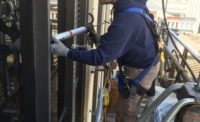Maintaining Profit Through Strategic Facility Decisions

In an ideal world, all equipment would be high performing, reliable, easy to maintain and efficient. Achieving these markers is a challenge, however. High-performing facilities rely heavily on effective teams and optimum performing equipment. When achieved, it has a direct positive impact on profit, increased resource conservation and reduced environmental impact.
On the other hand, underperforming equipment often runs longer and harder to achieve the desired result, which leads to increased utility charges, a shortened useful life for equipment and an increasingly negative environmental impact. Unreliable and inefficient equipment can also result in downtime, decreased production rates and financial losses.
Owners and operators should consider a facility assessment to understand risks and obtain strategies to help achieve their goals. Properly executed, an assessment is a low cost, objective review which provides priority-based recommendations.
RISK MANAGEMENT
Money is lost when equipment related issues exist. The question then becomes: How can one efficiently invest to mitigate equipment related issues? This is where risk management comes in. Risks are everywhere, and in the manufacturing environment, risks are often associated with financial losses. Without a risk management plan and proper execution, one relinquishes control and opens the door to failure.
Proactive risk management efforts can mitigate hazards and other threats to a facility’s operations. With a proactive approach, owners and operates can foresee potential threats and make course corrections early to control any impact to cost and schedule.
Owners and operators should begin with an equipment risk assessment to determine where to focus efforts. This assessment identifies all assets and the risks associated with each. Each risk should then be analyzed for risk probability and risk impact, to understand the operational and financial impact when any asset fails to perform. The risk probability is a variable that will likely change over time depending on whether proactive maintenance efforts exist or not. Risk impact, however, is often a fixed value if the nature of the operation remains unchanged. Many strategies exist to mitigate impact from identified risks, and each should be considered on a case-by-case basis.
Once the Risk Management assessment is complete, a “Risk Management Plan” and associated strategy for each asset should be developed, addressing the asset that poses the highest risk to operations first. Common strategies include escalating, avoiding, transferring, mitigating, and accepting. These risk mitigation strategies will vary depending on where each asset is within its life cycle.
EQUIPMENT AND SYSTEM LIFE CYCLE
Each piece of equipment and facility system has a journey, from concept and design to construction, commissioning, maintenance, and replacement. Each leg of the journey offers opportunities to mitigate failure and underperformance, ultimately helping to maintain profit.
Design
Risk management strategies are easiest to implement when they are considered in the concept and design phase. For example, sensors that notify facility operations of equipment issues could be part of the initial design. While installing these sensors may carry a front-end cost, these proactive measures often result in significant benefits throughout the equipment’s life span. A knowledgeable commissioning agent can provide design review to identify any issues that would prevent or inhibit the design from functioning as intended.
Construction and Installation
What works great on paper during the design phase is based on equipment cutsheets with representative data that was measured under ideal conditions. Inevitably, the field conditions will be different. Equipment should have an adequate structural foundation, be aligned, statically and dynamically balanced, and isolated from external forces to realize maximum potential. Project Specifications should require the use of precision installation, laser alignment, vibration analysis, pipe strain, pressure testing and infrared thermography to facilitate the construction and installation phase of the life cycle.
Equipment Startup
Equipment startup is usually conducted by one of two parties: the installing contractor or the manufacturer’s representative. An effective equipment startup includes steps such as the verification of lubricants and belts, and the removal of shipping locks and tools from cabinets. The equipment is typically brought online slowly and run through its full range of control. The installation operations and maintenance manual should provide specific instructions on the startup procedure.
The third-party commissioning authority often witnesses startup, and should take additional or confirming readings, capture baselines, and verify KPI’s (Key Performance Indicators) are being met. Conclusion of startup should prove that all equipment and systems are running properly and efficiently.
Commissioning, Re-commissioning or Retro-commissioning
Commissioning is a methodical process. It involves systematic processes of verifying and documenting systems and equipment are planned, designed, installed, tested, operated, and maintained to achieve project requirements. The goal of commissioning is to turn over a building that delivers, or exceeds, the performance and energy savings promised by its design. It is not uncommon that a Commissioning Authority (CxA) encounters systems that do not work as designed. A knowledgeable CxA will help provide solutions to achieve the desired result. Properly executed, commissioning leads to systems which are reliable, repeatable, maintainable, and efficient.
Building commissioning is one method that owners and operators can utilize to save energy, and ultimately, money. Commissioning is the process that sees that the building’s systems and equipment are installed and work correctly and efficiently. It also provides an opportunity to identify and correct any suboptimal operating conditions. Owners and operators are also commonly motivated to perform building commissioning to gain benefits to system performance, thermal comfort, and indoor air quality.
Buildings that are not commissioned will cost 8-20% more to operate than one that is commissioned, as reported by the U.S. Department of Energy. Therefore, the payback of commissioning can be relatively quick — the cost of performing commissioning is typically paid back in less than five years from energy savings alone.
Operations and Maintenance
Facilities do not simply become high-performing, and they do not sustain this level of performance without an intentional operations and maintenance strategy. The quality of a maintenance program can also be the difference between proactive and reactive costs. Proactive maintenance programs often include preventative maintenance, predictive maintenance, reliability centered maintenance, oil analysis, vibration analysis and ongoing commissioning. General maintenance and critical spare parts should be readily available to keep equipment operational.
Equipment Replacement
Owners and operators now have access to an increasing number of technologies that support proactive equipment replacement. With the ability to identify equipment that needs to be replaced before it fails, facilities can minimize downtime and maintain smooth operations, rather than derailing work with equipment reaches the end of its useful life.
LEVERAGING EXISTING INFRASTRUCTURE
Many owners and operators use some sort of control and management system to monitor and control their facility. An energy management control system or programmable logic controller uses inputs from various sensors and a logical sequence of operations with defined set points to control equipment and devices. Most systems utilize normal modes of operation in addition to a set of alarm conditions, failure modes and associated responses. Control systems typically contains a wealth of data that can be downloaded and analyzed to help identify positive and negative building and equipment trends. Some facilities contain monitoring and metering systems to track and trend energy usage in the form of electricity, natural gas, steam, and water. A thorough assessment of Energy Management Control System (EMCS) monitoring and metering data can identify operating conditions that may negatively impact a facility production and/or a company’s profit.
Maintenance management systems are also commonly found in facilities. Computerized maintenance management systems (CMMS) often contain a wealth of historical information about a facility, to include preventative maintenance frequency and findings, equipment failure and cause, equipment system and runtime durations, the number of starts, particulate matter and size, total maintenance time spent on assets, and maintenance consumables used. Analysis of information from a CMMS is useful to identify repeat maintenance offenders. It also aids in determining the reliability and failure rate of an asset and helps determine which risk management strategy to implement.
DATA DRIVEN STRATEGY
Modern facilities are controlled by a system of digital and analog signals traveling back and forth between equipment and a centralized computer system, coupled with a programmed sequence of operation (SOO): Building Automation System (BAS), Energy Management Control System (EMCS), or Direct Digital Controls (DDC). No matter which of these your company uses, the strategy remains similar; a computer program gives instructions to equipment devices (motors, actuators, valves, etc.) based on a Sequence of Operation. The equipment sensors (flow, pressure, temperature, location, etc.) provide real-time feedback, which is used to drive changes to the devices. The result is automated equipment which makes constant changes and adjustments, as needed, to achieve a defined result.
If your facility operates as described above, it is likely that you already have the infrastructure required to implement a smart building solution. Setup and implementation of a software package followed by configuration might be all you need to start making better decisions. Making decisions based on quantifiable data results in cost and energy savings. These “Intelligent Buildings” (IB) benefit from increased equipment reliability & uptime, reduced alarm & trouble calls, increased occupant comfort, and reduced maintenance. Digital Commissioning, Remote Monitoring, and Fault Detection Diagnostics (FDD) are some just a few of the choices that are available within the IB world.
FACILITY ASSESSMENT
Investing in a facility assessment can help owners and operators understand the complexities of achieving high-performance by identifying the right approach for each piece of equipment or system. The results of a facility assessment provide a tailored pathway to achieving a high-performing facility. A typical assessment begins with a review of available design documents, data from control and management systems, maintenance records, and risk assessments. It is then followed by a site visit to investigate equipment and systems within the facility. This information is then used to create a report and recommended plan for each asset.
Individual equipment or system condition assessments are a logical approach if limited equipment is of concern. A review of existing preventative maintenance plans will also help determine the efficacy of maintenance programs and changes that can be made to increase equipment reliability.
CONCLUSION
The needs of each facility are as unique as the professionals who work in them. A facility assessment can quickly identify areas of improvement in a building systems’ performance, prioritize high-risk assets and establish a plan that meets the owner’s current facility requirements and leads to future cost savings. Owners and operators should seek to partner with teams that have an in-depth understanding of facility assessments and how to turn findings into actionable and cost saving results.
David M. Camden, PMP, CxA: David leads the Commissioning Group for Affiliated Engineers Inc in the Pacific Northwest. Dave previously served the citizens of The United States of America, as a Utilities Equipment Repair Technician with the U.S. Army’s 82nd Airborne. Many of the systems and equipment he maintained were lifesaving / mission critical systems and failure was not an option. With more than 20 years of experience, Dave has held professional roles in the design, installation, operation, maintenance, facility planning, commissioning, and facility assessment areas. Dave’s current role is centered in Commissioning and Condition Assessments with a focus on Reliability, Efficiency, Maintainability, and Resource Conservation.
Looking for a reprint of this article?
From high-res PDFs to custom plaques, order your copy today!






